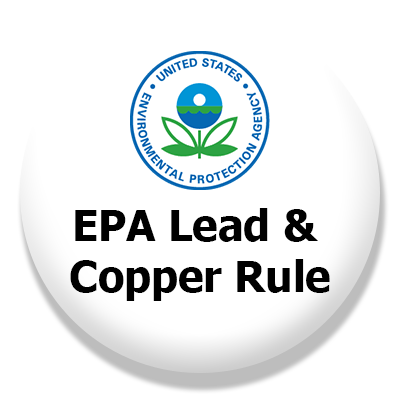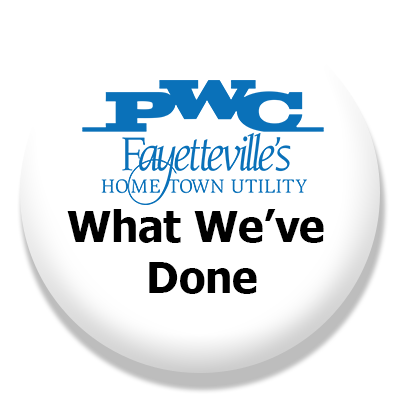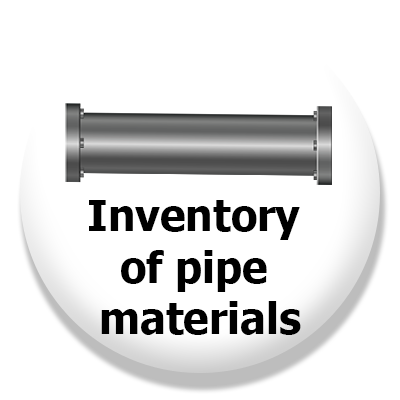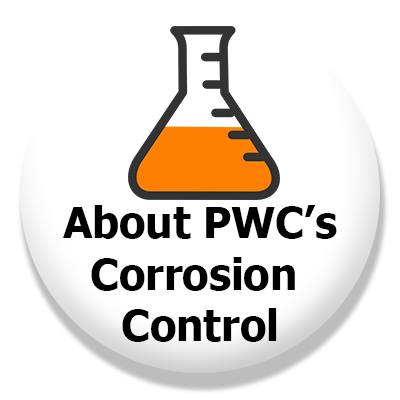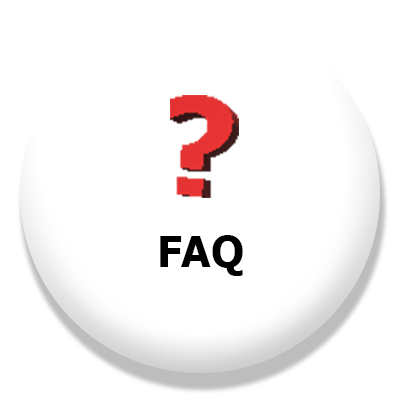Operation Clean & Clear

PWC is continuing its proactive measures to protect customers from lead exposure by conducting an inventory of all water service lines maintained by PWC as well as service lines connected to PWC lines. In 2022, PWC began a water system improvement project that will identify all water service lines in our distribution system and determine whether homes and businesses have any lead lines. Based on records and knowledge of our system, we anticipate there to be minimal instances of lead service lines, but we will be documenting all locations.
Any locations within our system that we can’t confirm with existing data, PWC will need customers to provide information about the types of materials used for the pipes connecting their property to PWC water mains. These efforts will ensure PWC is in compliance with the latest revision of the Safe Drinking Water Act-Lead and Copper Rule. Through Operation Clean and Clear, PWC will be a resource for educating customers about potential lead materials in their homes and businesses and by 2024, will provide an online resource for identifying properties with lead lines/plumbing.
To learn more about how to identify and record your pipe materials, visit the Inventory of Pipe Materials section of this webpage.
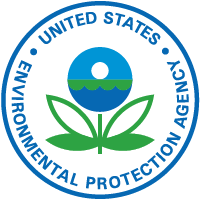
If you are concerned about lead in your water, information on lead in drinking water, testing methods, steps you can take to minimize exposure and additional information is available from the Safe Drinking Water Hotline (800-426-4791) or at www.epa.gov/safewater/lead.
Visit www.epa.gov/dwreginfo/lead-and-copper-rule for more information about the Lead and Copper Rule.
EPA Lead and Copper Rule
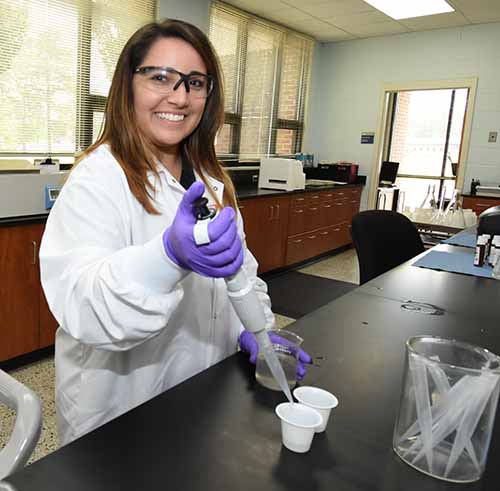
Revisions to the Safe Drinking Water Act (SDWA) were signed into law in 1986 prohibited the use of lead piping in plumbing. Since then, there have been a series of changes and new regulations in continuing efforts to protect the public from lead exposure through drinking water. Lead in drinking water is primarily from materials and components associated with service lines and home plumbing.
The latest revision to the 1991 Lead and Copper rule, lowers the level for required actions for utilities, revises sampling protocols, increases communications and requires utilities to provide a public resource for the types of material used throughout the water system.
Because elevated levels of lead can cause serious health problems, especially for young children, the latest revisions to the EPA rule include additional focus on schools and day cares. PWC has conducted an inventory of the service lines connecting to local schools and licensed day cares. You can view the results of the inventory below:
Since some customers have service laterals installed more than 35 years ago, records related to service laterals no longer exist. In order to complete the inventory, PWC conducted site surveys at select water meters of customers where records no longer exist. This information was compiled into a database to help engineer’s predict the types of service lines in local neighborhoods. For the remainder of our customers where the materials of the service lines are unknown, customers are being asked to identify the type of pipes in the home and fill out a self-verification form online or by returning a prepaid postage postcard.
The new changes to the Lead and Copper Rule require water providers to do an annual notification to all customers with lead, galvanized steel, or unknown service lines. This notification will be required until the water service line containing lead is replaced or the materials used in the service line is verified to not contain lead.
What We’ve Done
PWC’s drinking water is safe and meets or surpasses all EPA drinking water standards. PWC was the first utility in North Carolina to earn the Environmental Protection Agency (EPA) Director’s Award for our extra efforts in providing clean, safe drinking water and has maintained that prestigious recognition for 20 consecutive years.
Since 1991, PWC has participated in the lead and copper sampling program as required by the Safe Drinking Water Act (SDWA). As a result, PWC implemented a corrosion control program to stop lead from the pipes and fixtures from entering the water system. This corrosion control program has been successful in that all of PWC’s samples are well below the EPA mandated thresholds for lead in drinking water.
In 1997, PWC obtained reduced monitoring based on three years of sampling data that indicated our corrosion control program was effective and our system followed the requirements of the SDWA pertaining to lead and copper. Since that time, PWC tests a minimum of fifty locations once every three years. The most recent testing was 2020 in which no lead was detected. Additionally, PWC collects tap water samples for customers on a requested basis.
Inventory of pipe Materials
Fayetteville PWC is conducting an inventory to identify the types of pipe materials connected to our water mains as part of our Operation Clean & Clear program. The EPA requires water providers to maintain a record of the types of pipes connected to the utility’s water mains and meters, including the privately owned water service lines that connect a property to the water main. PWC needs customers to check their water service lateral lines where it comes into the home and share the results. Service laterals are pipes that connect main water lines to an individual home or business. While lead piping was banned in 1987, and known lead lines installed prior to 1987 have been replaced over the years, PWC has nearly 100,000 water laterals in its system that require documentation.
Based on records and knowledge of the PWC system, we anticipate there to be minimal instances of lead service lines, but we will be documenting all locations.
In addition to PWC service lines, new rules require the identification of lead materials that may exist on the customer’s water line that connects the PWC meter to their home or business. While PWC is responsible for providing high quality drinking water distributed through the PWC system, it cannot control the variety of materials used on private property nor has any existing records verify if lead may exist. Copper piping with lead solder as well as lead service lines are more likely to be found in homes built before 1986. Among homes without lead service lines, brass or chrome-plated brass faucets may also create lead exposure.
How to identify the types of pipes in your plumbing
Identifying the types of pipes are used in your home’s plumbing can be done easily; you will need a flashlight, a magnet, and a tool to scratch the pipes with, like a flat head screwdriver. The first step is to go to the basement or crawlspace of your home closest to the water main, which typically runs along the street. Look for the pipe coming through the wall or ground into your home and connecting to your homes plumbing.
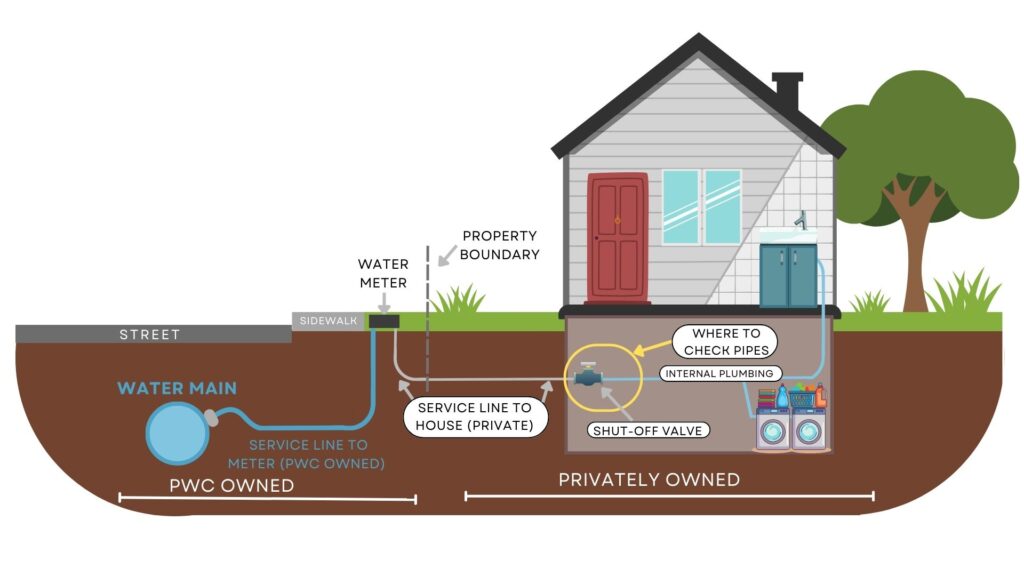
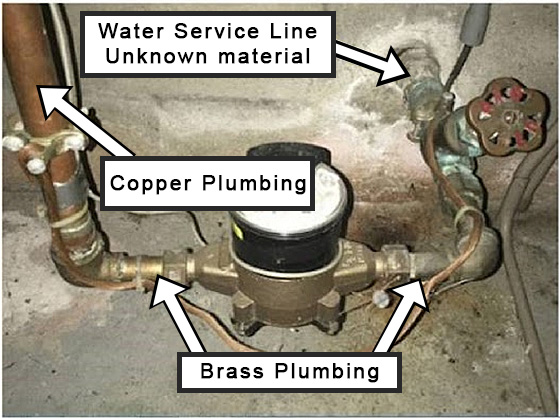
Visually examine the service line coming into your home. Plastic pipes are fairly easy to visually identify, but metal pipes may need you to do the scratch and magnet tests to tell the difference.
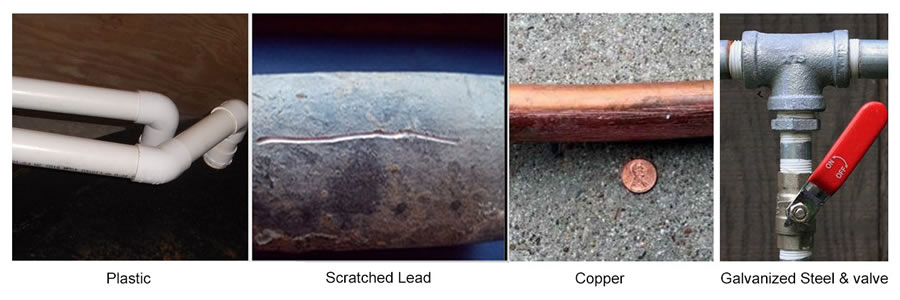
- Brass- Brass pipes are metal pipes and brown or dull yellow colored with green corrosion spots. Scratches on a brass pipe are gold colored. Brass pipes use threaded connections and magnets will not stick.
- Plastic- Plastic pipes can be white, black, red, or blue in color and smooth to the touch. Plastic is easy to scratch with your tool and magnets will not stick to plastic pipes.
- Lead- Lead pipes are made of metal and easy to scratch with your tool , scratches will be shiny and silver colored. Magnets will not stick to lead and lead pipes will often bulge where it connects to the homes plumbing.
- Copper- Copper pipes are metal pipes and dull brown or green in color. When scratched, it will be the same color as a penny. Magnets will not stick to copper.
- Galvanized Steel- Galvanized steel are metal pipes, gray or silver in color, and not easy to scratch with your tool. Additionally, magnets will stick to the metal and steel uses threaded connections.
If you have located your service lines and unsure of the pipe materials, take a picture. You can submit digital copies of the photos when responding to the survey online or by email. Staff can look at the photos and identify the pipe materials.
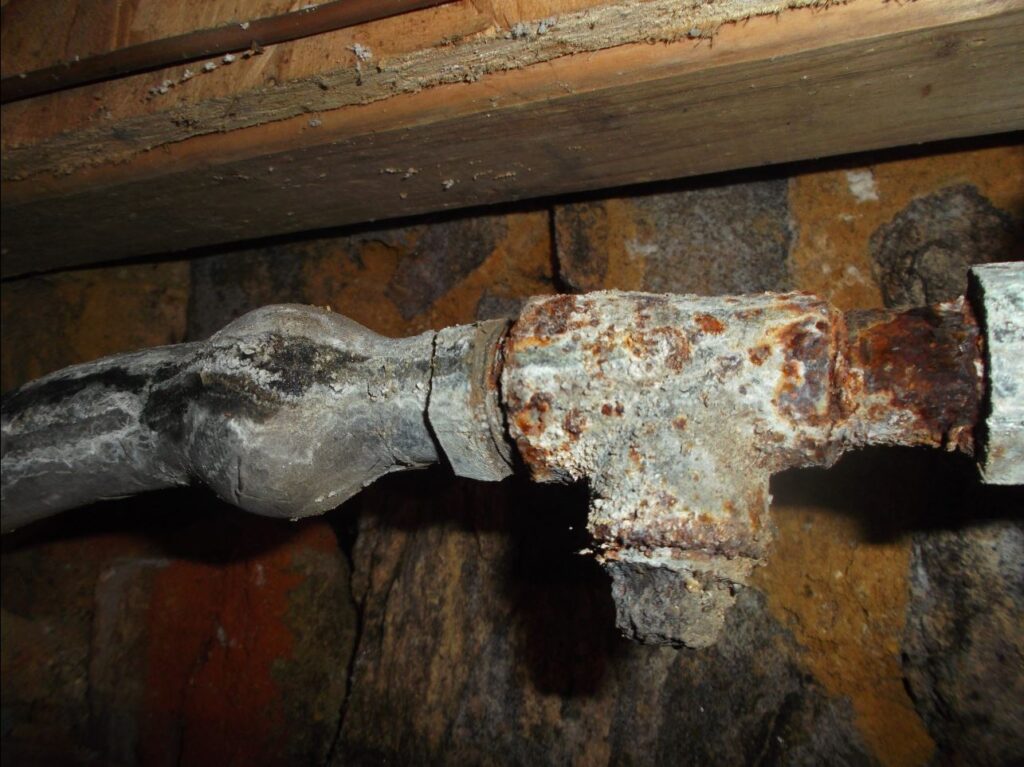
Informational Sessions
PWC hosted several Information Sessions for Operation Clean & Clear. The meetings were an opportunity to learn more about the program, answer questions about the program, as well as have examples of the different types of plumbing to help home owners with knowing what to look for when checking their plumbing. For customers who were unable to attend one of the meetings and wanted to learn more, a recording of the first meeting is available for viewing.
The Fayetteville Public Works Commission has contracted with the company, 120Water, to collect the information and create a database as well as a searchable and interactive map. In order to comply with federal requirements, PWC needs customers to submit their inventory results to be in our database and accessible via an interactive map. The survey is accessible online and can be completed by visiting this link to 120Water’s website.
For a spanish language version of the self-verification postcard, click on the image of the postcard below. Para obtener una versión en español de la postal de autoverificación, precione en la imagen de la postal abajo.
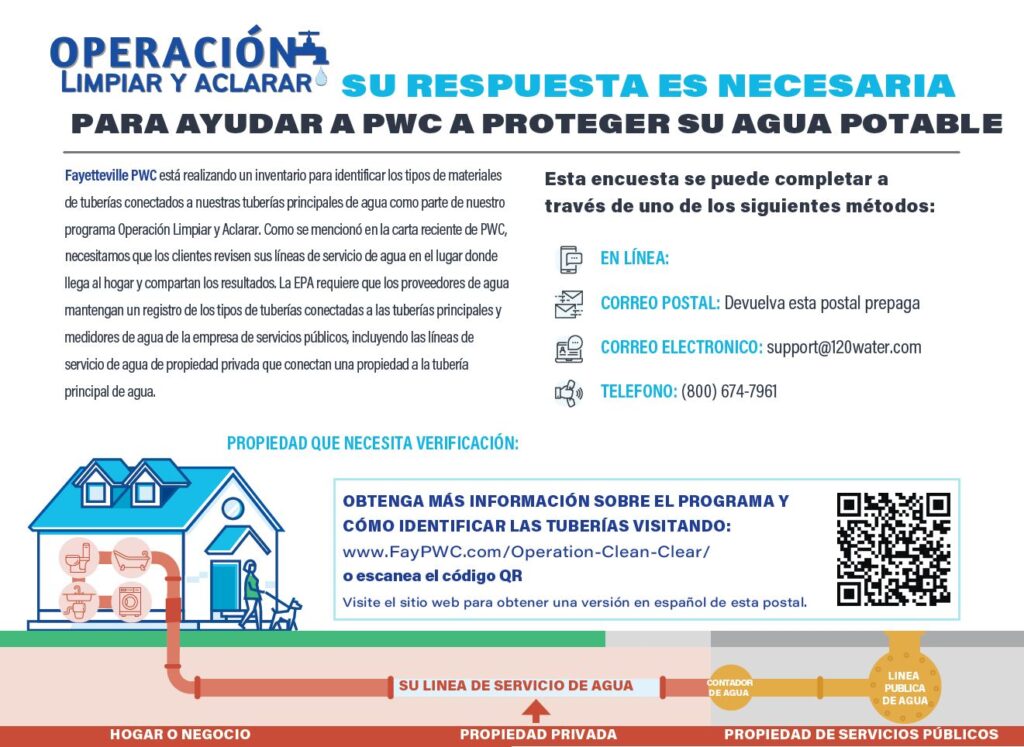
Interactive Map
To view the map and see what materials are used in water laterals in your area, use the map below or visit the dedicated website at 120Water. In order to comply with federal requirements, PWC needs customers to submit their inventory results to be in our database and accessible via an interactive map. The survey is accessible online and can be completed by visiting this link to 120Water’s website.
About pWc’s corrosion Control
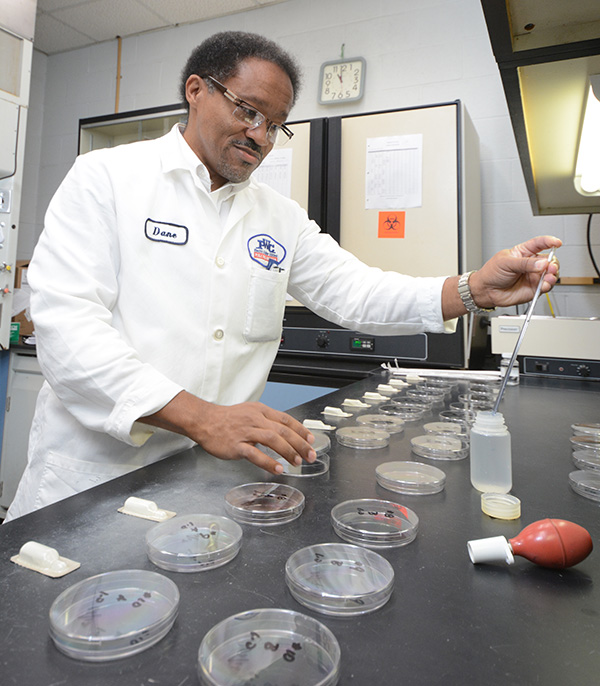
PWC corrosion control measures meets or exceeds the variety of water quality levels mandated by the Environmental Protection Agency (EPA) and the North Carolina Department of Environmental Quality (NCDEQ), formally known at the North Carolina Department of Environmental and Natural Resources (NCDNER). PWC implemented the use of zinc-orthophosphate for corrosion control in 1994 for our water distribution system. Following the implementation and based on positive results of its use, in January of 1997, after reviewing three years of lead level analysis, the NCDENR notified PWC that they considered our water system’s corrosion control to be optimized.
Because of our optimized corrosion control, PWC’s requirements of our lead and copper monitoring sites and analysis frequency was reduced by state authorities. This reduced monitoring stage came with a list of water quality parameters that we were required to monitor, as well as set ranges that could not be exceeded. The water quality parameters are such things as pH, corrosion inhibitor dose, alkalinity, and calcium levels.
Along with maintaining these water quality parameters, PWC has a continuous corrosion coupon analysis system in place. Eight mid-steel coupons are placed throughout the distribution system where they remain in contact with our drinking water for a period of 90 days. After 90 days, the steel coupons are removed and sent to a lab to measure what changes have occurred in “corrosion rate factor”. We continuously monitor this factor for any changes in the corrosivity of our water. Since switching to zinc-orthophosphate, we remained in compliance with the Lead and Copper Rule, and we have maintained the above-mentioned water quality parameters within the state’s established ranges for optimized corrosion control.
In 2008, as a result of our change in primary coagulants from Aluminum Sulfate to Ferric Sulfate in our water treatment process, we performed another corrosion control study to ensure that our change in coagulants had not adversely affected our corrosion control plan. The year-long bench-scale test at the P.O. Hoffer WTF compared the zinc-orthophosphate we were using was compared to four other leading corrosion inhibitor blends. The orthophosphate that we had been using since January 1994 was shown to still be the best inhibitor for corrosion control so that PWC remained in compliance with the Lead and Copper Rule, and have maintained the above-mentioned water quality parameters within the established ranges for optimized corrosion control.
Click here to read more about the latest testing results for PWC’s corrosion control measures submitted to the EPA.
If you would like to have your water tested by an independent laboratory for lead contamination, below is a list of local labs who will test your water for a fee. Coordination and payment of this testing is the property owner’s responsibility and does not involve any work that PWC will be performing.
- Microbac Laboratories, Inc.
- 2592 Hope Mills Rd, Fayetteville, NC 28306
- www.microbac.com
- (910) 864-1920
- Meritech, Inc.
- 642 Tamco Rd, Reidsville, NC 27320
- www.meritechlabs.com
- (336) 342-4748
- Environmental Chemists, Inc.
- 6602 Windmill Way, Wilmington, NC 28405
- www.perryenvironmental.com
- (910) 392-0223
- Element One, Inc.
- 6319 Carolina Beach Rd, Wilmington, NC 28412
- www.e1lab.com
- (910) 793-0128


